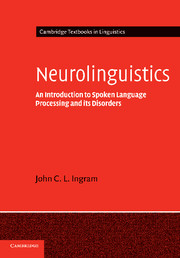Book contents
- Frontmatter
- Contents
- List of figures
- List of tables
- Preface and acknowledgements
- Note on the text
- Part I Foundational concepts and issues
- Part II Speech perception and auditory processing
- Part III Lexical semantics
- Part IV Sentence comprehension
- 12 Sentence comprehension and syntactic parsing
- 13 On-line processing, working memory and modularity
- 14 Agrammatism revisited
- Part V Discourse: language comprehension in context
- Glossary
- References
- Index
12 - Sentence comprehension and syntactic parsing
Published online by Cambridge University Press: 26 January 2010
- Frontmatter
- Contents
- List of figures
- List of tables
- Preface and acknowledgements
- Note on the text
- Part I Foundational concepts and issues
- Part II Speech perception and auditory processing
- Part III Lexical semantics
- Part IV Sentence comprehension
- 12 Sentence comprehension and syntactic parsing
- 13 On-line processing, working memory and modularity
- 14 Agrammatism revisited
- Part V Discourse: language comprehension in context
- Glossary
- References
- Index
Summary
Introduction
In this chapter we discuss the role of syntactic processing in sentence comprehension. As elsewhere in this book, we will approach this question from a dual perspective. Firstly, we shall examine the sentence comprehension strategies of people who, as a result of brain injury, appear to have lost their facility to utilize the grammatical rules of their language, and suffer a condition known as agrammatism. This is roughly equivalent to posing the (perhaps somewhat naive) question: if one loses one's syntax, what are the consequences for sentence comprehension? In exploring this question, we shall review the first generation of psycholinguistic investigations into a core topic of aphasia research and set the stage for contemporary inquiries employing sophisticated on-line behavioural and neuroimaging techniques.
The second major theme of the present chapter concerns the processing of syntactically ambiguous and ‘garden path’ sentences by perfectly fluent native listeners. Sentences which can be syntactically read or ‘parsed’ more than one way, or which initially lead us ‘up the garden path’ towards a misconstrual that we are subsequently forced to re-analyse, have the potential to tell us much about how the human parser works. We shall introduce both of these major themes of the aphasic and psycholinguistic literature informally in this chapter, through appeal to your linguistic intuitions as native speakers of English, leaving it to the subsequent chapter to deal with methodological issues of ‘on-line’ processing and how we might infer the mental and neural operations that take place in apparent real time when we understand spoken language.
- Type
- Chapter
- Information
- NeurolinguisticsAn Introduction to Spoken Language Processing and its Disorders, pp. 243 - 265Publisher: Cambridge University PressPrint publication year: 2007

